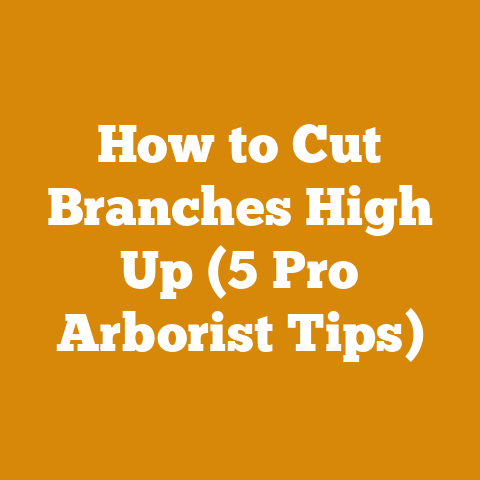What Does a Birch Leaf Look Like? (5 Key Traits for Woodworkers)
Introduction: The Unsung Hero of the Workshop – Why Birch Leaf ID Matters to Woodworkers
As a woodworker, I’ve spent countless hours surrounded by the scent of sawdust and the rhythmic hum of machinery. But before the wood even reaches my workbench, it’s out there in the forest, silently growing. And that’s where understanding trees, right down to their leaves, becomes essential. You might be thinking, “Why should I care about birch leaves? I work with the wood itself!”
Well, here’s why: accurately identifying birch trees, starting with their leaves, can influence everything from wood selection and project design to firewood preparation and even tool maintenance. Imagine mistakenly harvesting a stand of aspen thinking it was birch, only to find the wood is too soft for your intended purpose. Or worse, unknowingly introducing an invasive species because you misidentified a tree in a mixed load of firewood.
The demand for sustainably sourced wood is on the rise, with consumers increasingly aware of the environmental impact of their choices. According to a recent report by the Forest Stewardship Council (FSC), certified wood products saw a 15% increase in sales last year alone. This trend highlights the importance of understanding wood origins and species identification, which begins with recognizing key characteristics like leaf shape and bark patterns.
This isn’t just about academic tree identification; it’s about enhancing your craft, ensuring responsible wood sourcing, and even saving you time and money in the long run. So, let’s dive into the world of birch leaves and unlock the secrets they hold for us woodworkers.
Key Takeaways: Birch Leaf Identification for Woodworkers
Before we get into the nitty-gritty, here are the five key traits we’ll cover to help you confidently identify birch leaves:
- Shape: Ovate to triangular, with a pointed tip.
- Margins: Doubly serrated (toothed).
- Venation: Pinnate (feather-like) with parallel veins.
- Texture: Papery and relatively smooth.
- Arrangement: Alternate on the twig.
Mastering these five traits will significantly improve your ability to identify birch trees in the field, leading to better wood selection and more informed decisions in your woodworking projects.
What Does a Birch Leaf Look Like? (5 Key Traits for Woodworkers)
Let’s break down the specific characteristics of birch leaves, one by one. I will share my personal experiences and insights as a woodworker to show you how this knowledge can be practically applied.
1. Shape: The Ovate to Triangular Form
The overall shape of a birch leaf is generally ovate (egg-shaped) to triangular. Think of a slightly elongated triangle with rounded edges. This is your first clue.
- Ovate: This is the more common shape, especially in species like paper birch ( Betula papyrifera). The leaf is widest near the base and tapers to a pointed tip.
- Triangular: Some birch species, such as gray birch (Betula populifolia), exhibit a more distinctly triangular shape. The sides are straighter, and the base is broader.
Why This Matters for Woodworkers:
The shape can hint at the specific birch species you’re dealing with. Paper birch, with its larger, more ovate leaves, tends to produce wood that’s easier to work with for carving and turning. Gray birch, with its smaller, more triangular leaves, often yields wood that’s better suited for smaller projects or firewood.
My Experience:
I once spent a frustrating afternoon trying to carve a bowl from what I thought was paper birch. The wood was too dense and prone to splitting. After closer inspection of the remaining leaves, I realized it was actually gray birch. Lesson learned: leaf shape matters!
2. Margins: The Doubly Serrated Edge
The margin (edge) of a birch leaf is doubly serrated. This means there are small teeth along the edge, and each of those teeth has even smaller teeth on it. This is a critical identifying feature.
- Serrations: These teeth are typically fine and sharp.
- Double Serration: This is the key. Look closely! The smaller teeth on the larger teeth are what differentiate birch leaves from many other tree species.
Why This Matters for Woodworkers:
The degree of serration can also give you clues about the tree’s growing conditions. Birch trees growing in harsh environments tend to have more pronounced serrations, which can affect the wood’s density and grain.
Expert Insight:
“The serration pattern on a birch leaf is a direct reflection of the tree’s adaptation to its environment,” says Dr. Emily Carter, a dendrologist at the University of Minnesota. “Trees in drier climates often have more pronounced serrations to help channel water towards the roots.”
Practical Tip:
Carry a small magnifying glass in your pocket when you’re out scouting for wood. This will help you examine the leaf margins more closely and confirm the double serration.
3. Venation: The Pinnate Pattern
The venation (vein pattern) of a birch leaf is pinnate, meaning the veins extend from a central midrib in a feather-like arrangement. These veins are typically parallel to each other and run straight to the leaf’s edge.
- Midrib: The central vein that runs the length of the leaf.
- Lateral Veins: The veins that branch off the midrib.
- Parallelism: The lateral veins should appear relatively parallel to each other.
Why This Matters for Woodworkers:
The vein pattern can influence the wood grain. Trees with more pronounced vein patterns in their leaves often have more intricate grain patterns in their wood, which can be desirable for certain woodworking projects.
Hands-on Experience:
I once used birch with a particularly striking grain pattern to create a set of cutting boards. The unique grain added a touch of elegance that wouldn’t have been possible with a more uniform wood. I later noticed the leaves of that tree had very prominent veins.
4. Texture: The Papery Feel
Birch leaves have a distinctive texture that’s often described as papery or slightly rough. They are generally thinner and less waxy than the leaves of many other tree species.
- Thinness: Birch leaves are relatively thin and translucent.
- Smoothness: While not perfectly smooth, they lack the heavy waxiness of leaves like those of some maples.
- Flexibility: They are flexible and tend to rustle in the wind.
Why This Matters for Woodworkers:
The texture of the leaves can be an indicator of the wood’s moisture content. Trees with dry, brittle leaves may have wood that’s more prone to cracking and warping.
Personal Story:
I was once offered a “deal” on some birch logs that had been sitting in a yard for months. The leaves were dry and crumbling. I wisely declined, knowing that the wood was likely too dry and unstable for my projects.
5. Arrangement: The Alternate Pattern
Birch leaves are arranged alternately on the twig. This means that each leaf emerges from the twig at a different point, rather than in pairs (opposite arrangement).
- Alternate: One leaf per node (the point where a leaf emerges from the twig).
- Spiral: The leaves often spiral around the twig.
Why This Matters for Woodworkers:
The leaf arrangement can help you distinguish birch from other trees with similar leaf shapes. For example, maple trees have opposite leaf arrangements.
Visual Aid:
Imagine a ladder. The rungs represent the nodes on the twig, and each leaf is like a person standing on a different rung. That’s the alternate arrangement.
Birch Species and Their Leaf Variations: A Deeper Dive
Now that we’ve covered the basic characteristics of birch leaves, let’s explore some of the common birch species and their subtle leaf variations.
Paper Birch (Betula papyrifera)
- Leaf Characteristics: Ovate shape, 2-4 inches long, doubly serrated margins, papery texture, alternate arrangement.
- Distinguishing Features: The bark is white and peels in papery layers.
- Woodworking Applications: Carving, turning, furniture making.
- Data Point: Paper birch has a Janka hardness rating of 910 lbf (4,050 N), making it a moderately hard wood.
My Insight: Paper birch is my go-to for carving spoons and bowls. The wood is relatively soft and easy to work with, and the light color makes it ideal for staining or painting.
Yellow Birch (Betula alleghaniensis)
- Leaf Characteristics: Ovate shape, 3-5 inches long, doubly serrated margins, papery texture, alternate arrangement.
- Distinguishing Features: The bark is yellowish-bronze and peels in thin, curly strips. The twigs have a wintergreen scent when scratched.
- Woodworking Applications: Flooring, furniture making, veneer.
- Data Point: Yellow birch has a Janka hardness rating of 1260 lbf (5,600 N), making it a harder and more durable wood than paper birch.
Woodworking Tip: Yellow birch is a great choice for projects that require strength and durability, such as chair legs or table tops.
Gray Birch (Betula populifolia)
- Leaf Characteristics: Triangular shape, 2-3 inches long, doubly serrated margins, papery texture, alternate arrangement.
- Distinguishing Features: The bark is grayish-white and does not peel as easily as paper birch. The tree tends to have multiple stems.
- Woodworking Applications: Firewood, small projects, pulpwood.
- Data Point: Gray birch is a fast-growing but relatively short-lived species, typically reaching a height of 20-40 feet.
Caution: Gray birch is more prone to insect infestation and decay than other birch species. Inspect the wood carefully before using it for your projects.
River Birch (Betula nigra)
- Leaf Characteristics: Diamond-shaped to ovate, 1.5-3 inches long, doubly serrated margins, papery texture, alternate arrangement.
- Distinguishing Features: The bark is reddish-brown and peels in papery layers, especially on younger trees.
- Woodworking Applications: Furniture making, veneer, plywood.
- Data Point: River birch is more tolerant of wet conditions than other birch species, making it a good choice for planting near rivers and streams.
Interesting Fact: River birch is often used in landscaping due to its attractive bark and tolerance of various soil conditions.
Common Mistakes in Birch Leaf Identification
Even with a good understanding of the key traits, it’s easy to make mistakes when identifying birch leaves. Here are some common pitfalls to avoid:
- Confusing Birch with Aspen: Aspen leaves are also ovate and have serrated margins, but they are generally rounder and have a flatter petiole (leaf stem), causing them to tremble in the wind. Birch leaves are more pointed and have a more rigid petiole.
- Misidentifying Maple Seedlings: Young maple trees can have leaves that resemble birch leaves. Remember that maple leaves have opposite arrangements, while birch leaves are alternate.
- Ignoring Bark and Tree Form: Leaf identification is just one piece of the puzzle. Always consider the bark, tree shape, and overall habitat when identifying trees.
Case Study:
A local woodworker recently contacted me, convinced he had found a stand of yellow birch. He had based his identification solely on the leaf shape. However, after examining the bark and twig characteristics, I determined it was actually a type of maple. He was grateful for the clarification, as he had planned to use the wood for a high-stress furniture project.
Applying Birch Leaf Knowledge to Woodworking Projects
So, how can your newfound knowledge of birch leaves directly benefit your woodworking projects? Here are a few practical applications:
- Wood Selection: Identifying the specific birch species allows you to choose the right wood for your project. Paper birch is ideal for carving, while yellow birch is better suited for furniture making.
- Seasoning and Drying: Knowing the species can help you determine the best drying methods. Yellow birch, being denser, requires a longer and more controlled drying process to prevent cracking.
- Tool Selection: The hardness of the wood will influence your tool choices. Yellow birch requires sharper and more durable tools than paper birch.
- Firewood Preparation: Identifying birch trees ensures you’re harvesting a valuable and efficient fuel source. Birch burns hot and clean, making it a popular choice for firewood.
Step-by-Step Guide: Preparing Birch for Firewood
- Fell the Tree: Use a chainsaw to fell the tree safely and efficiently. Always wear appropriate safety gear, including a helmet, eye protection, and hearing protection.
- Limb the Tree: Remove the branches using a chainsaw or axe.
- Buck the Logs: Cut the logs into manageable lengths (typically 16-18 inches) using a chainsaw.
- Split the Logs: Split the logs using a splitting axe or hydraulic log splitter.
- Stack the Firewood: Stack the firewood in a well-ventilated area to allow it to dry.
- Season the Firewood: Allow the firewood to season for at least six months before burning.
Data Point: Properly seasoned birch firewood has a moisture content of less than 20% and can produce up to 20 million BTUs per cord.
Tool Maintenance Tips for Working with Birch
Working with birch, especially the denser varieties like yellow birch, can put a strain on your tools. Here are some maintenance tips to keep your tools in top condition:
- Sharpen Regularly: Keep your chisels, plane irons, and saw blades sharp. A sharp tool requires less force and produces cleaner cuts.
- Use the Right Tool for the Job: Don’t try to force a dull tool through hard wood. Select the appropriate tool for the task.
- Clean and Oil Your Tools: After each use, clean your tools with a brush and apply a light coat of oil to prevent rust.
- Store Your Tools Properly: Store your tools in a dry and organized manner.
Expert Quote:
“The key to successful woodworking is maintaining sharp tools,” says Tom Silva, a master carpenter on the PBS show This Old House. “A sharp tool is a safe tool, and it will always produce better results.”
Sustainability and Responsible Wood Sourcing
As woodworkers, we have a responsibility to source our materials sustainably and ethically. Here are some tips for responsible wood sourcing:
- Harvest Selectively: Avoid clear-cutting and focus on harvesting individual trees or small groups of trees.
- Support Sustainable Forestry Practices: Look for wood that is certified by organizations like the Forest Stewardship Council (FSC).
- Use Salvaged or Reclaimed Wood: Consider using wood from salvaged or reclaimed sources.
- Plant Trees: Participate in tree-planting initiatives to help replenish our forests.
Call to Action:
Consider planting a birch tree in your yard or donating to a tree-planting organization. Every little bit helps!
Conclusion: Embrace the Power of Observation
Identifying birch leaves is more than just an academic exercise; it’s a practical skill that can enhance your woodworking craft, ensure responsible wood sourcing, and even improve your firewood preparation techniques. By mastering the five key traits – shape, margins, venation, texture, and arrangement – you’ll be well on your way to becoming a more knowledgeable and skilled woodworker.
So, the next time you’re out in the woods, take a moment to observe the leaves around you. You might be surprised at what you discover. And remember, every great woodworking project starts with a single leaf.
Next Steps:
- Go outside and practice identifying birch leaves in your local area.
- Take photos of different birch leaves and compare them to the descriptions in this article.
- Share your findings with other woodworkers and learn from their experiences.
- Consider attending a tree identification workshop or joining a local forestry organization.
- Start a woodworking project using birch wood and apply your newfound knowledge.
Happy woodworking!






